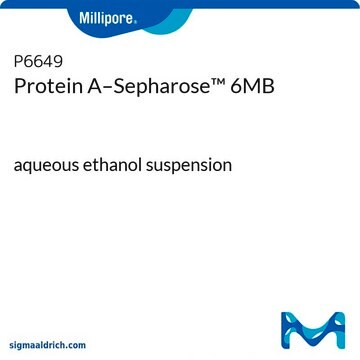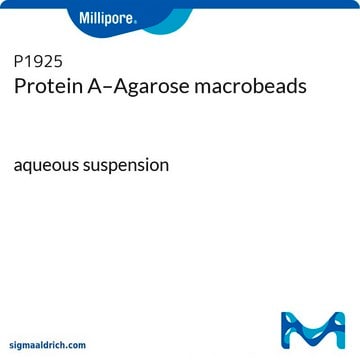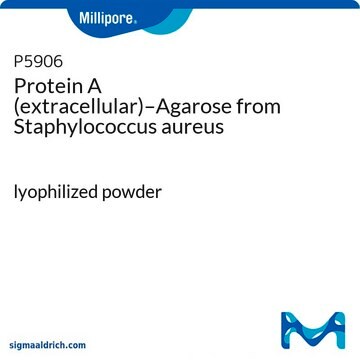P2545
Protein A–Agarose
saline suspension
Synonym(s):
Protein A resin
Sign Into View Organizational & Contract Pricing
All Photos(1)
About This Item
Recommended Products
biological source
Staphylococcus aureus
form
saline suspension
extent of labeling
~2 mg per mL
matrix activation
cyanogen bromide
matrix attachment
amino
matrix spacer
1 atom
capacity
≥15 mg/mL binding capacity (human IgG)
storage temp.
2-8°C
Looking for similar products? Visit Product Comparison Guide
General description
Protein A is a 42-kDa protein from Staphylococcus aureus and has five immunoglobulin binding domains.
Application
Protein A−Agarose has been used in the immunoprecipitation
- of protein phosphatase and tensin homolog (PTEN) protein from S63 and NIH3T3 fibroblast cells
- of prolyl hydroxylase domain 2 N27 cells
- of Wnt3a and sonic hedgehog (Shh) in mouse fibroblast L-cells and human embryonic kidney (HEK) 293 cells
Protein A-agarose is used for affinity chromatography, antibody purification and characterization, and protein A, G and L resins. Protein A-agarose has been used to study the effects of protein A immunoadsorption in patients with chronic dilated cardiomyopathy as well as to study multiple sclerosis and gastric cancer.
Biochem/physiol Actions
Protein A binds to Fcγ (the constant region) and Fab (antigen binding fragment) of IgG. Protein A agarose resin is commercially used for affinity based purifications.
Physical form
Suspension in 0.5 M NaCl containing preservative
Storage Class Code
10 - Combustible liquids
WGK
WGK 3
Personal Protective Equipment
dust mask type N95 (US), Eyeshields, Gloves
Certificates of Analysis (COA)
Search for Certificates of Analysis (COA) by entering the products Lot/Batch Number. Lot and Batch Numbers can be found on a product’s label following the words ‘Lot’ or ‘Batch’.
Already Own This Product?
Find documentation for the products that you have recently purchased in the Document Library.
Customers Also Viewed
Madhu Chhanda Mohanty et al.
Developmental and comparative immunology, 26(4), 385-391 (2002-03-13)
Meriones unguiculatus commonly known as gerbils are widely used as animal models for a variety of parasitic infections such as Brugia malayi, Entamoeba histolytica, Giardia duodenalis, Toxoplasma gondi, Helicobacter pylori, Strongyloides stercoralis and Echinococcus multilocularis. Groups of BALB/c mice, gerbils
D J McCool et al.
The Biochemical journal, 341 ( Pt 3), 593-600 (1999-07-27)
Molecular chaperones are presumed to associate with large secretory mucin glycoproteins during their synthesis in the endoplasmic reticulum (ER), but have not been identified to date. We decided to look for possible involvement of the chaperones calreticulin (CRT) and calnexin
D J McCool et al.
The Biochemical journal, 302 ( Pt 1), 111-118 (1994-08-15)
Pulse-chase labelling experiments were performed using the mucin-producing colonic carcinoma cell line LS180. Cells were pulsed with [3H]threonine or [3H]glucosamine and chased in complete media without radiolabel for various lengths of time. From cell and media extracts obtained at each
PTEN-Dependent Stabilization of MTSS1 Inhibits Metastatic Phenotype in Pancreatic Ductal Adenocarcinoma
Zeleniak AE, et al.
Neoplasia, 20(1), 12-24 (2018)
Membrane targeting of palmitoylated Wnt and Hedgehog revealed by chemical probes
Gao X, et al.
Febs Letters, 585(15), 2501-2506 (2011)
Our team of scientists has experience in all areas of research including Life Science, Material Science, Chemical Synthesis, Chromatography, Analytical and many others.
Contact Technical Service








